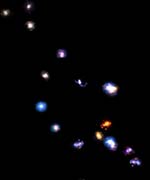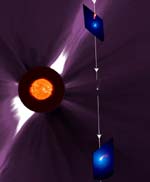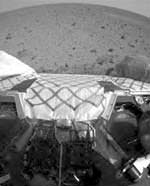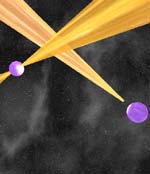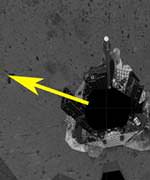
Image credit: NASA/JPL
After several attempts to collapse the airbag which is blocking Spirit’s exit from the lander, controllers have given up that plan. Instead, they’ve decided to have the rover exit from one of the platform’s alternate ramps. In order to take this northeastern route, the rover will have to back up and then perform a three-point turn in the tight space. Controllers will also fire a pyro device which will sever an umbilical cord connecting the rover to the lander. If everything goes as planned, Spirit will roll off the lander on the evening of January 14.
NASA’s Spirit rover now has its arm and all six of its wheels free, and only a single cable must be cut before it can turn and roll off its lander onto the soil of Mars. As that milestone is completed, scientists are taking opportunities to take extra pictures and other data.
During the past 24 hours — the rover’s 8th martian day on the planet, or “sol 8” — pyro devices were fired slicing cables to free the rover’s middle wheels and releasing pins that held in place its instrumented arm. The arm was then locked onto a hook where it will be stowed when the rover is driving.
Because one airbag remains adjacent to the lander’s forward ramp, the rover will turn about 120 degrees to its right and exit the lander from the side facing west-northwest on the planet — also the direction of an intriguing depression that scientists have dubbed Sleepy Hollow.
Current plans call for the rover to complete that turn in three steps, said Arthur Amador, one of the mission managers at NASA’s Jet Propulsion Laboratory, Pasadena, Calif. As currently envisioned, during the coming martian day engineers will complete ground tests and execute dress rehearsals of the drive-off, or “egress.”
On sol 10 — the night of Monday-Tuesday, Jan. 12-13, California time — engineers expect to sever the umbilical cord that connects the rover to its lander by firing a pyro device, the last of 126 pyro firings since Spirit separated from its cruise stage shortly before landing on Jan. 4 (Jan. 3 in U. S. time zones). Also on that day, the rover will execute the first of three parts of its turn when it moves clockwise (as viewed from above) about 45 degrees.
After taking and analyzing pictures to verify the first part of the turn, engineers anticipate completing it on sol 11 (night of Tuesday-Wednesday, Jan. 13-14). First, the rover will turn an additional 50 degrees and stop to take pictures. Then, if all is well, it will turn a final 20 to 25 degrees to position it precisely in front of one of its three exit ramps.
If no issues crop up as those steps are completed, the rover could drive off onto the martian soil no earlier than sol 12 (night of Wednesday-Thursday, Jan. 14-15). “But we adjust our schedule every day, based on flight events, so this remains an estimate,” said Amador.
The rover’s status overall is “pretty darn perfect,” said Amador. He described the communication link from Mars to Earth as excellent, allowing the team to receive 170 megabits of data during the past day. All science data stored on the rover has been sent to Earth. The rover is generating 900 watt-hours of power per day and using 750 watt-hours, and its thermal condition is good, he added.
While engineers are completing and testing commands to execute the rover’s turn and egress, the science team is enjoying an “unexpected dividend” of time to collect data, said Dr. John Callas, Mars Exploration Rover science manager at JPL.
Until now, all science observations have been planned far in advance, but the unfolding schedule of rover activities gave the team the opportunity to do their first on-the-fly planning for observations driven by previous results, Callas explained. In doing so they segued to a working style that they will practice on a day to day basis as the rover rolls across the surface of its landing site in Gusev Crater, named the Columbia Memorial Station.
In the next 24 hours, the team will collect 270 megabits of science data, considerably more than on any previous martian day. This will include a high-quality, 14-color mosaic taken by the panoramic camera of a third of the horizon toward Sleepy Hollow, the direction in which the rover will leave its lander.
In addition, they plan to complete two remaining “octants” (each a pie slice showing an eighth of the horizon) with the rover’s miniature thermal emission spectrometer. These areas will also be rephotographed with the rover’s panoramic camera in order to allow the camera and spectrometer data to be co-registered. Plans also call for the spectrometer to “stare” at three selected sites to collect very low-noise data, as well as calibration of another science instrument, the alpha particle X-ray spectrometer.
Spirit’s twin Mars Exploration Rover, Opportunity, will reach Mars on Jan. 25 (Universal Time and EST; Jan. 24 PST). The rovers’ main task is to spend three months exploring for clues in rocks and soil about whether the landing sites may have had abundant water for long enough in the past for life to appear. Pictures and detailed information from the mission is available at the project’s Web site: http://marsrovers.jpl.nasa.gov.
JPL, a division of the California Institute of Technology, manages the Mars Exploration Rover project for NASA’s Office of Space Science, Washington.
Original Source: NASA/JPL News Release




